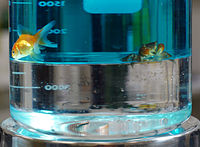
Photo from wikipedia
The development of methodologies for inducing and tailoring activities of catalysts is an important issue in various catalysis. The ultrathin 2D monolayer metal-organic framework (MOF) nanosheets with more accessible active… Click to show full abstract
The development of methodologies for inducing and tailoring activities of catalysts is an important issue in various catalysis. The ultrathin 2D monolayer metal-organic framework (MOF) nanosheets with more accessible active sites and faster diffusion obtained by exfoliating 3D layered MOFs are of great potential as heterogeneous catalysts, but the rational design and preparation of 3D layered MOFs remains a grand challenge. Herein, a novel weak electrostatic interaction strategy to construct a 3D layered cerium-bearing MOF by coordinating chlorine-capped cerium nodes and linear photoactive methyl viologen (MV+ ) organic linkers is used. Under multiphoton excitation, the MV+ ligands and CeCl chromophores are triggered consecutively to form the high activity chlorine radical (Cl• ) for activation of inert C(sp3 )H bond through a hydrogen atom transfer. Benefiting from framework confinement effects, synergistic effects of two active sites and/or flexibility of the ultrathin framework nanosheets with high surface utilization, the observed activities increase in the order CeCl3 /MV+ < bulk 3D MOF crystals < 2D MOF nanosheets in photocatalysis. This work not only contributes a new strategy to construct 3D layered MOFs and their ultrathin nanosheets but also paves the way to use nanostructured MOFs to handle synergy of multiple molecular catalysts.
Journal Title: Small
Year Published: 2023
Link to full text (if available)
Share on Social Media: Sign Up to like & get
recommendations!